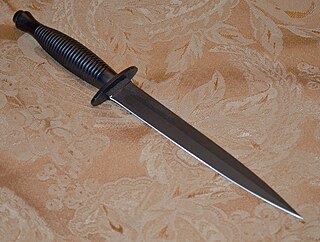 W
WA dagger is a knife with a very sharp point and usually two sharp edges, typically designed or capable of being used as a thrusting or stabbing weapon. Daggers have been used throughout human history for close combat confrontations, and many cultures have used adorned daggers in ritual and ceremonial contexts. The distinctive shape and historic usage of the dagger have made it iconic and symbolic. A dagger in the modern sense is a weapon designed for close-proximity combat or self-defense; due to its use in historic weapon assemblages, it has associations with assassination and murders. Double-edged knives, however, play different sorts of roles in different social contexts.
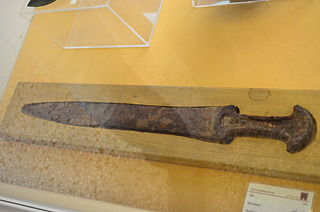 W
WThe acinaces, also spelled akinakes or akinaka is a type of dagger or short sword used mainly in the first millennium BC in the eastern Mediterranean region, especially by the Medes, Scythians, Persians and Caspii, then by the Greeks.
 W
WAn anelace was a medieval dagger worn as a gentleman's accoutrement in 14th century England.
 W
WIn modern terminology, the Arkansas toothpick is a heavy dagger with a 12-to-20-inch pointed, straight blade. The knife can be used for thrusting and slashing. James Black, known for improving the Bowie knife, is credited with inventing the Arkansas toothpick.
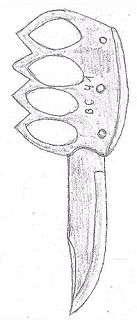 W
WThe BC-41 was a combined knuckleduster and dagger weapon used by the British Commandos during World War II for close combat and ambush situations. Although effective, it was eventually replaced by the Fairbairn-Sykes Fighting Knife.
 W
WThe bichuwa or bichawa is a dagger, originating from the Indian subcontinent, with a loop hilt and a narrow undulating sharp blade. It is named for its resemblance to the sting of a scorpion, for which the Hindi name is bichuwa. The weapon was based on the maduvu, or horn dagger created in South India, and many bichuwa have blades which retain the shape of buffalo horns. Early examples of the bichuwa come from the medieval southern empire of Vijayanagara. Being relatively easy to make, the bichuwa has persisted into the 20th century as a decorative dagger.
 W
WBlakas or Belakas is a general name for any sort of cleaver or large knife originating from Bali, Indonesia that has a heavy rectangular blade with a straight cutting edge used for chopping. The long, rounded hilt often becomes thinner at one or both ends. The blade often has a fanciful shape and encrusted motifs. Sometimes it is made for ceremonial purposes, and also used in pairs with golok. It is a common utensil in Balinese households and is used for kitchen chores, orchard work, and in ceremonial activities.
 W
WA bollock dagger or ballock knife is a type of dagger with a distinctively shaped hilt, with two oval swellings at the guard resembling male testes ("bollocks"). The guard is often in one piece with the wooden grip, and reinforced on top with a shaped metal washer. The dagger was popular in Scandinavia, Flanders, Wales, Scotland and England between the 13th and 18th centuries, in particular the Tudor period. Within Britain the bollock dagger was commonly carried, including by Border Reivers, as a backup for the lance and the sword. Many such weapons were found aboard the wreck of the Mary Rose. The bollock dagger is the predecessor to the Scottish dirk.
 W
WA boot knife or a gambler's dagger is a small fixed-blade knife that is designed to be carried in or on a boot. Typically, such a knife is worn on a belt or under a pant leg. If worn around the neck they become a neck knife. Boot knives generally come with a sheath that includes some form of a clip. Most have double-edged blades, like a dagger, that range from 3 to 5 inches.
 W
WA cimpaba is a sword from the Woyo of the Democratic Republic of Congo.
 W
WThe cinquedea or cinqueda is a civilian short sword. It was developed in northern Italy and enjoyed a period of popularity during the Italian renaissance of the 15th and early 16th centuries.
 W
WAn ear dagger is a relatively rare and exotic form of dagger that was used during the late Middle Ages and Renaissance. It is so named because the pommel of the dagger has a very distinctive shape, somewhat resembling a human ear. Ear daggers frequently have a single sharpened edge that ends in an acute point.
 W
WA facón is a fighting and utility knife widely used in Argentina, Brazil, and Uruguay as the principal tool and weapon of the gaucho of the South American pampas. Often fitted with an elaborately decorated metal hilt and sheath, the facón has a large, heavy blade measuring from 25 cm to 51 cm in length.
 W
WThe Fairbairn–Sykes fighting knife is a double-edged fighting knife resembling a dagger or poignard with a foil grip. It was developed by William Ewart Fairbairn and Eric Anthony Sykes in Shanghai based on ideas that the two men had while serving on the Shanghai Municipal Police in China before World War II.
 W
WThe French Nail were locally fabricated and converted bayonets, knives and stabbing weapons for use in the First World War. These were crude stabbing spikes made by adding a point to a steel stake which had its rearmost section heated and bent into a crude handle.
 W
WAn ikul or ikula is a knife or a short sword of the Kuba of the Democratic Republic of Congo.
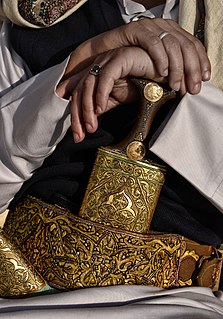 W
WA jambiya, also spelled janbiya, jambya, jambia and janbia, is a specific type of dagger with a short curved blade with a medial ridge that originated from Hadhramaut and Yemen. It is most closely associated with the people of Yemen, Saudi Arabia and Somalia. Men typically above the age of 14 wear it as an accessory to their clothing. The janbiya is commonly referred to in Oman as a khanjar, Hyderabad (India) as Jambiya, xencer in Kurdistan region.
 W
WThe Jile, also known as a Gile in Afar language, in Somali known as Qolxad or Toorey, is a type of dagger with a long curved blade found in Djibouti, Ethiopia, Somalia, and Eritrea. Unique to the Horn of Africa, it is the most famous and characteristic of Afar and Somali daggers. It is closely related to the Yemeni janbiya, which it highly resembles.
 W
WThe katar or katara is a type of push dagger from the Indian subcontinent. The weapon is characterized by its H-shaped horizontal hand grip which results in the blade sitting above the user's knuckles. Unique to the Indian subcontinent, it is the most famous and characteristic of Indian daggers. Ceremonial katars were also used in worship.
 W
WA khanjali is a double-edged dagger often with a single off-set groove on each face of the blade. The shape of the weapon is similar to the ancient Roman Gladius, the Scottish dirk and the ancient Greek Xiphos, and has been used as a secondary weapon in Georgia and the Caucasus since ancient times.
 W
WA khanjar is a traditional dagger originating from Oman. Worn by men for ceremonial occasions, it is a short curved sword shaped like the letter "J" and resembles a hook. It can be made from a variety of different materials, depending on the quality of its craftsmanship. It is a popular souvenir among tourists and is sold in souqs throughout the region. A national symbol of the sultanate, the khanjar is featured on Oman's national emblem and on the Omani rial. It also features in logos and commercial imagery by companies based in Oman.
 W
WThe kirpan is a sword or a knife of any size and shape, carried by Sikhs. It is also part of a religious commandment given by Guru Gobind Singh in 1699, in which he gave an option to the Sikhs, if they accepted they must wear the five articles of faith at all times, the kirpan being one of five Ks.
 W
WThe kris or keris in the Indonesian and Malay languages, is an asymmetrical dagger with distinctive blade-patterning achieved through alternating laminations of iron and nickelous iron (pamor). Of Javanese origin, the kris is famous for its distinctive wavy blade, although many have straight blades as well, and is one of the weapons commonly used in the pencak silat martial art native to Indonesia.
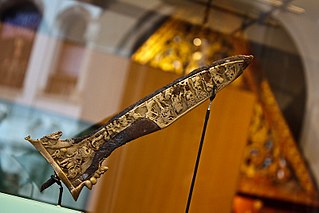 W
WThe Kris of Knaud, also known as the Keris of Knaud or Knaud's Kris, is the oldest known kris surviving in the world. Given to Charles Knaud, a Dutch physician, by Paku Alam V in the 19th century, the kris is on display at the Tropenmuseum, Royal Tropical Institute in Amsterdam.
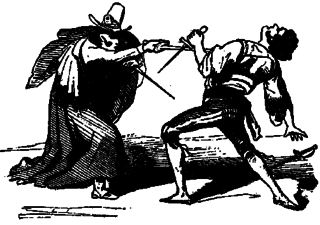 W
WThe parrying dagger is a category of small handheld weapons from the European late Middle Ages and early Renaissance. These weapons were used as off-hand weapons in conjunction with a single-handed sword such as a rapier. As the name implies they were designed to parry, or defend, more effectively than a simple dagger form, typically incorporating a wider guard, and often some other defensive features to better protect the hand as well. They may also be used for attack if an opportunity arises. The general category includes two more specific types, the sword breaker and trident dagger.
 W
WA Malappuram kathi is a kind of dagger, originating from the Indian subcontinent, developed by few blacksmith families of Malappuram from Malabar region of Kerala in ancient times. The dagger is unique in its physical appearance and features, as it has a very light-weight holder made of deer antler. The blade is thicker on the top and very sharp and lines at the bottom. The blade continues to the handle and covers the handle in a small single strip. The dagger is 18–25 inches (46–64 cm) long.
 W
WA mambele is a form of hybrid knife/axe in central and southern Africa, originating from a curved throwing dagger used by the Mangbetu.
 W
WThe Mark I trench knife is an American trench knife designed by officers of the American Expeditionary Force (AEF) for use in World War I. It has a 6.75 in (17.1 cm) double-edged dagger blade useful for both thrusting and slashing strokes, unlike previous U.S. trench knives such as the M1917 and M1918. The handle is made of cast bronze and uses a conical steel nut to hold the blade in place. The Mark I's blade was blued with a black oxide finish, the bronze handle was chemically blackened, with cast spikes on the bow of each knuckle. The spikes were intended to prevent an opponent from grabbing the knife hand, as well as to provide a more concentrated striking surface when employed in hand-to-hand combat.
 W
WA Ngulu is an execution sword used by the Bantu peoples of the Congo Basin.
 W
WAn onzil is a throwing knife of ethnic groups from eastern Gabon.
 W
WThe parrying dagger is a category of small handheld weapons from the European late Middle Ages and early Renaissance. These weapons were used as off-hand weapons in conjunction with a single-handed sword such as a rapier. As the name implies they were designed to parry, or defend, more effectively than a simple dagger form, typically incorporating a wider guard, and often some other defensive features to better protect the hand as well. They may also be used for attack if an opportunity arises. The general category includes two more specific types, the sword breaker and trident dagger.
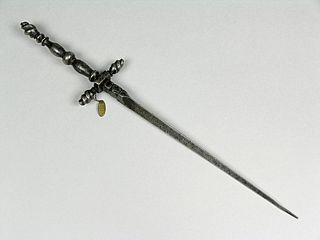 W
WA poniard or poignard (Fr.) is a long, lightweight thrusting knife with a continuously tapering, acutely pointed blade and crossguard, historically worn by the upper class, noblemen, or the knighthood. Similar in design to a parrying dagger, the poniard emerged during the Middle Ages and was used during the Renaissance in Western Europe, particularly in France, Switzerland, and Italy.
 W
WThe pugio was a dagger used by Roman soldiers as a sidearm. It seems likely that the pugio was intended as an auxiliary weapon, but its exact purpose for the soldier remains unknown. Officials of the empire took to wearing ornate daggers in the performance of their offices, and some would wear concealed daggers for defense in contingencies. The dagger was a common weapon of assassination and suicide; for example, the conspirators who stabbed Julius Caesar used pugiones. The pugio developed from the daggers used by the Cantabarians of the Iberian peninsula.
 W
WA push dagger is a short-bladed dagger with a "T" handle designed to be grasped in the hand so that the blade protrudes from the front of one's fist, typically between the index and middle finger. It originates as a close-combat weapon for civilians in the early 19th century, and has also seen some use in the trench warfare of World War I.
 W
WThe rencong is a type of knife originating in Aceh, Indonesia. Originally a fighting weapon, it is most often seen today in the martial art of silat and worn during traditional ceremonies.
 W
WA rondel dagger or roundel dagger was a type of stiff-bladed dagger in Europe in the late Middle Ages, used by a variety of people from merchants to knights. It was worn at the waist and might be used as a utility tool, or worn into battle or in a jousting tournament as a side arm.
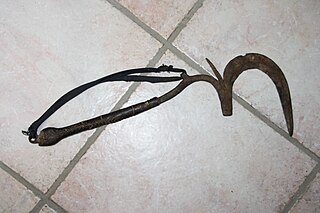 W
WA sengese is a throwing knife of the Matakam from northeastern Nigeria or northern Cameroon.
 W
WSewar refers to a dagger of Indonesian origin, typically carried in a belt and used mainly in Sumatra, Indonesia. The blade is also referred to as Sewah by the Gayo people, Seiva by the Minangkabau people, Siva by the Alas people, and Siwaih by the Acehnese people.
 W
WThe sgian-dubh is a small, single-edged knife worn as part of traditional Scottish Highland dress along with the kilt. Originally used for eating and preparing fruit, meat, and cutting bread and cheese, as well as serving for other more general day-to-day uses such as cutting material and protection, it is now worn as part of traditional Scottish dress tucked into the top of the kilt hose with only the upper portion of the hilt visible. The sgian-dubh is normally worn on the same side as the dominant hand.
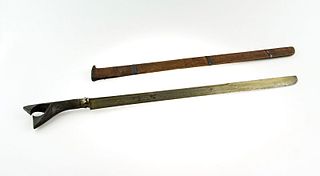 W
WSikin Panjang is a sword originated from northern Sumatra, Indonesia.
 W
WThe SS-Ehrendolch was considered an honour weapon of the SS of the Nazi Party (NSDAP). In addition to this dagger there was also the SS Honour Ring and SS Honour Sword. The awarding ceremony was conducted according to strict rules developed by Heinrich Himmler.
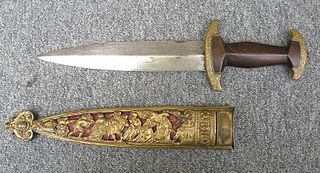 W
WThe Swiss dagger (Schweizerdolch) is a distinctive type of dagger used in Switzerland and by Swiss mercenaries during the 16th century. It develops from similar dagger types known as basler which were in use during the 14th and 15th centuries. The characteristic mark of the Swiss dagger are two crescent-shaped, inward-bent metal bars delimiting the hilt.
 W
WThe Topkapi Dagger is a renowned emerald studded curved dagger, a jambiya, of mid-18th century origin. It is preserved and publicly displayed at the treasury of the Topkapi Palace Museum in Istanbul, Turkey. One side of the handle of the dagger is set with three large Colombian emeralds whose size and prominence make it an outstanding and valuable object. It is also decorated with many small diamonds.
 W
WA trench knife is a combat knife designed to kill or incapacitate an enemy at close quarters, such as in a trench or other confined area. It was developed as a close combat weapon for soldiers attacking enemy trenches during the First World War. An example of a World War I trench knife is the German Army's Nahkampfmesser.
 W
WA trumbash or trombash is a Mangbetu throwing knife from the Democratic Republic of Congo.
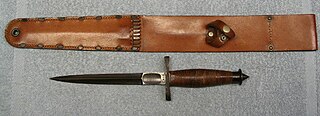 W
WThe V-42 stiletto was a stiletto and fighting knife issued during World War II to the First Special Service Force, a joint American/Canadian commando unit.
 W
WA vendetta knife is a type of dagger associated with the vendetta, the traditional feuds of Corsica.